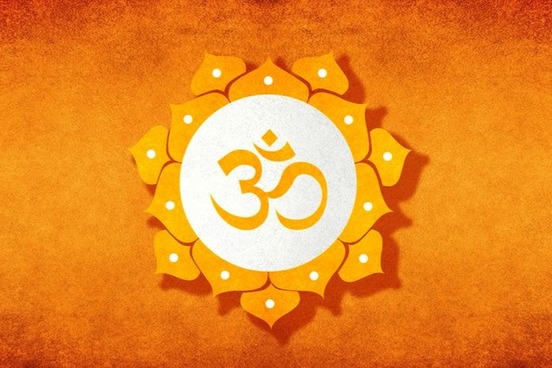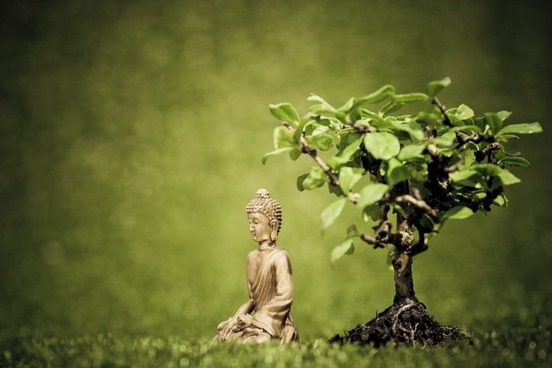
Nirvana
English readers of religious philosophy were first enlightened on the Buddhist concept of nirvana in the early 19th century. The word is a borrowing from Sanskrit that means "the act of extinguishing" and, in Buddhism, it refers to a state in which desire and one's conscious attachment to things in secular life (or, in particular, the negative emotions these desires/attachments bring about) are extinguished through disciplined meditation. Once these things are vanquished, peace, tranquility, and enlightenment are said to be fully experienced; ignorance dissolves and the truth becomes fully known.
In nirvana, a person also not only enters a transcendent state of freedom of all negativity but breaks free of the religion's beliefs in the continuous cycle of birth, death, and rebirth and the effects of karma—the force created by one's actions that is to determine what that person's next life will be like. A person who has gained insight into the true nature of existence in the cosmos and has achieved nirvana is known as an arhat, or an arahant, in some schools of Buddhism.
By the end of the 19th century, people were using nirvana figuratively for any secular state or place of great happiness and peace.
My favorite party scene is outdoors on brick-lined East 4th Street, a block of renovated buildings connected by strings of twinkling lights. It's people-watching nirvana even before you wander into the bars, clubs and restaurants….
— Fran Golden, The Los Angeles Times, 16 July 2017

Karma
A fundamental aspect of Buddhism is the teaching that you are responsible for your own life and your future circumstances (as well as your future lives)—whether you experience happiness, misery, etc.—and that your actions and behavior can bring good or bad karma. If you are kind to others, the belief is that they will be kind in return, but more importantly, that means you will experience good karma in your present and next life. On the other hand, if you are not nice to others, you will get your just deserts in some form in the near or distant future as well as in the next life through bad karma. The point is be careful about how you interact with others: everything you do decides what you have to contend with in transmigration.
The word karma is from Sanskrit, where, fittingly, it refers to one's work as well as one's fate; it begins appearing in English writing in the early 1800s. Hippie generations adopted the philosophical term in various senses referring to one's feelings, the emotional atmosphere, luck, or whatever is pleasant or pleasurable, and now karma is everyday.
While Roth was pregnant and struggling to keep food in the house for her other children, her family helped her and Proctor through their financial struggle. "Now we're in a more positive place in our lives, and we want to turn our bad karma into good karma," Roth said.
— The Hillsdale Collegian, 22 Mar. 2018

Mantra
A mantra in Buddhism (as well as in Hinduism) is a sacred utterance—be it a syllable, word, or verse—that is usually repeated or continued, either aloud or in one's thoughts, prayer, meditation, or ritual, and it is believed to induce a trancelike state in the participant that can lead him or her to a higher level of spiritual awareness. The name is from Sanskrit, where it means "sacred counsel" or "formula," and it is akin to Latin mens, meaning "mind."
One of the most widely used mantras in Hinduism, as well as Buddhism, is the sacred utterance om. In Hinduism, the trisyllabic a-u-m is also used and can represent the universal triad of earth, atmosphere, and heaven, or the Hindu gods Brahma, Vishnu, and Shiva. Buddhists also meditate with the syllabically longer, om maṇi padme hūṃ (maṇi means "jewel"; pademe, "lotus flower"; hūṃ represents the spirit of enlightenment).
The religious senses of mantra come about in English during the late 18th century. In the 20th century, it gained secular senses referring to a word or motto that embodies a principle or guide to action of an individual or group, as well as to a guiding principle.
My workout mantra is "Break a sweat every day," Even if it's just for 20 minutes. I'm very disciplined about that.
— Kate Hudson, quoted in Self, 30 Apr. 2014

Mandala
Mandala is the name of a Buddhist or Hindu mystic symbol of the universe that is represented as a circle (mandala literally means "circle" in Sanskrit) enclosing a square and bearing images of deities. It is used as an object in which to focus one's attention while meditating. Mandalas have been painted on paper or cloth, drawn on the ground, or fashioned in bronze or stone.
Multiple concentric circles can be delineated in a mandala; in such representations, each circle will have unique significance. For instance, a ring of fire may symbolize the burning of ignorance; a circle of diamonds might stand for illumination; a circle of graveyards might symbolize death; and a girdle of lotus leaves might signify spiritual rebirth.
If mentally "entering" the mandala and "proceeding" toward its center is too deep, you might try coloring one for relaxation.
Veterans with self-reported PTSD symptoms also showed decreased self-reported anxiety and stress after coloring a mandala—a geometric pattern derived from Hinduism and Buddhism—for 20 minutes.
— The Florida Times-Union, 27 Oct. 2018

Zen
Zen is the Japanese word for "religious meditation" that is distantly related to Sanskrit dhyāna, of similar meaning. In English, the word came to designate a Japanese school of Mahayana Buddhism that was established fully by the 12th century after a couple of earlier incarnations in China. The school of thought emphasizes self-discipline and the attainment of sudden enlightenment (called satori in Zen Buddhism) through meditation on nonlogical paradoxes; it is not focused on the practice of good deeds, rites and ceremonies, or worship like other religious schools of thought.
A common form of personal Zen meditation is zazen. Zazen involves sitting, usually erect with legs crossed and hands positioned together with palms up, and contemplating koans, which are paradoxical statements or questions worded to force one to abandon reason and gain insight into a transcendent truth. A well-known example is: "When both hands are clapped, a sound is produced; listen to the sound of one hand clapping."
Zen can also refer to the calm attentiveness and attitude of acceptance experienced after, and perhaps during (but contemplating koans is likely rather exhausting, so calmness during is questionable) Zen meditation, and, in general, to a feeling or attitude similar to that of a person who seems to have had a "Zen" experience, as in "running is my zen." A non-Buddhist in such a state might also be said to be "zen" or "very zen" when feeling calm and relaxed, and things serene are often referred to as "zen"—for instance, a rain forest on a non-rainy day can be zen.

Lama
Lama is a variation of Tibetan blama, meaning "superior one" (the "b" is silent). Since the 17th century, it has graced English writing as the name of a Buddhist priest or monk or, in general, a spiritual leader or advisor, such as the Dalai Lama (or Grand Lama) or the Panchen Lama.
Some lamas are considered reincarnations of their predecessors; others have won respect for their high level of spiritual development in their own right. The most honored of the reincarnate lamas is the Dalai Lama.
The process of discovering the new incarnation of a lama is exacting. Oracular messages and signs during the lama's death or during a birth thereafter are scrutinized, and when a would-be candidate is discovered, a thorough spiritual examination is conducted. Once identified, the lama's incarnation is given extensive monastic training from an early age.

Tantra
In Sanskrit, Tantra has the literal meanings of "warp," "essential part," and "doctrine." The word is based on tanoti, meaning "he stretches, weaves," and begins being seen and heard in English toward the end of the 18th century in reference to scriptures dealing with esoteric aspects of religious teaching. There is a considerable amount of Tantric literature and practice in both Buddhism and Hinduism sects. Because Tantric practices typically represent teachings of relatively late development and incorporate elements of different traditions that have no basis in canonical literature, they are often eschewed by orthodox practitioners.
For example, philosophically, Tantric Vajrayana is a blend of the Yogacara and Madhyamika disciplines, and it places special emphasis on the notion that enlightenment arises from the realization that seemingly opposite principles are in truth one. Another break from tradition in this form of Buddhism is the worship of goddesses. Additionally, Vajrayana uses innovative meditation practices involving the use of mantras and mandalas, as well as the use of yoga-based disciplined sexual activities, to facilitate the attainment of earthly benefits and spiritual enlightenment. In sum, Tantra is taboo to some Buddhists, but its practices are still performed today.

Dharma
Dharma, which in Sanskrit means "that which is established" (such as a religion, custom, law, or duty), refers to divine or moral law or the basic principles of cosmic or individual existence in Buddhism and Hinduism, which adhere to truthfulness, non-injury, and generosity, among other virtues. In Buddhism, it also names an ideal or universal truth as taught by Buddha, such as The Four Noble Truths, The Three Universal Truths (impermanence, suffering, and no self), and The Eightfold Path.
The triad of the Buddha, the dharma (doctrine), and the sangha (a Buddhist monastic order or a community) make up the Triratna, and a person becomes a Buddhist by saying the words "I go to the Buddha for refuge, I go to the Doctrine for refuge, I go to the Order for refuge"—recognizing this trinity.

Bodhi/Bodhisattva
Bodhi, which in Sanskrit means "he wakes, is awake," refers to the state of enlightenment that is attained by a Buddhist who has practiced the Eightfold Path and through which has rid themselves of false beliefs and the hindrance of passions; hence, they can enter nirvana, or spiritual release. This "awakening" transformed Siddhārtha Gautama into the revered Buddha while he sat under a fig tree. Bodhi is also used as the name for the fig tree, also known as the pipal.
A bodhisattva (or boddhisattva) is the name of a being (in Sanskrit, sattva means "being" as well as "essence") that compassionately refrains from entering nirvana in order to save others and is worshipped as a deity in Mahayana Buddhism. The compassion shown by the bodhisattva is referred to as karuna.

Pagoda
A pagoda is a towered structure in eastern Asia comprised of several stories in regularly diminishing proportions with a roof curving upward to a sharp point at the division of each; it is used either as a temple or memorial. Its unique structure is based on the ancient Indian stupa, a dome-shaped structure often topped by an umbrella (symbolizing protection) that is used to house relics or the remains of saints and kings. In time, the stupa became more elongated and cylindrical in design. It is this later form that Buddhism adopted as the structure for shrines.
The name pagoda is derived from Portuguese pagode, meaning "a statue of a deity" or "a Hindu or Buddhist temple," and goes back to the 1500s; however, it is first found in English texts in the spelling form pagode. The "a" spelling is not attested until the following century. The Portuguese word is likely related to Sanskrit bhagavatī, an epithet of Hindu goddesses and the feminine form of bhagavat, meaning "blessed" or "possessing good fortune."

Sutra
In Sanskrit, sūtra literally means "thread" but has the extended meanings of "precept," "string of rules," and "aphorisms." In Hinduism, sutras reflect this etymology: they are brief aphoristic phrases stringed together to express a truth or wisdom. An example is "Soul is; for there is no proof that it is not." In Buddhism, on the other hand, sutras are extended wordy discourses on the deeds and the teachings of the Buddha that constitute the basic text of Buddhist scripture. But they are also stringed together, so we can see the Sanskrit connection. Here is an excerpt:
You make things worse when you flare up at someone who's angry. Whoever doesn't flare up at someone who's angry wins a battle hard to win.

Samsara
Samsara is based on a Sanskrit word that means, literally, "passing through." It is used in Buddhism to refer to "passing through" the indefinitely repeated cycles of birth, suffering, death, and rebirth that are determined by karma. To transcend these wanderings in samsara, a person must attain nirvana.
A variety of explanations of the workings of the karmic process within samsara have been proposed. According to several, the soul after death first goes to a heaven or hell until it has consumed its good or bad karma. It is then reborn in accordance with the remainder of its good/bad karma. (Basically, it comes down to the age-old question of "Are you a good witch or a bad witch?")
Supposedly, some people can remember their previous lives, which is the basis for the Buddhist Jataka, a collection of moralistic tales in which the Buddha gives accounts of his previous lives (jāta means "born" in Sanskrit). The Buddha, apparently, remembers, knows, relates, and lives on.





